#herpetological shapeshifter
Explore tagged Tumblr posts
Text
Meet Rio.

He's a Herpetological shapeshifter - meaning he can out of all animals shapeshift only into lizards and amphibians.
After many months since the wall broke and people began to spread their explorations and supply searches, far in more tropical lands the rumours of brave knights and hero shapeshifter that saved everyone reach to a creature, who would like to meet this shapeshifter to see that he's not alone.
After crawling in a tiny gecko form on one of the supply boxes, he makes it into the city and disguised as a frog he searches for the brave knights who could lead him to the said shapeshifter. And upon hearing who is the bravest of them all, he follows this said Ambrosius and appears in his flat, asking him to take him to their hero.
Once meeting Nimona it's a great shock for everyone that there are more like them and Nimona is all but happy that she isn't alone anymore.
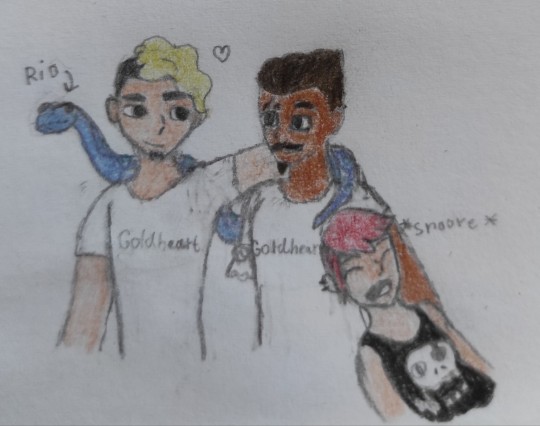
A few things about him:
Pronounce: He/him
Sexuality: Demi romantic ace gay
Lives with Ambrosius who is trying to be a good influence on him, make him feel welcomed and wants to proof him that their kind are more than bunch of judgemental jerks. He also knows that with Nimona he would cause chaos and he doesn't want to let that happen. He also reminds him of little Bal who is happy that his boyfriend wants to try what it's like to be in his skin.
He loves: chips, popcorn, steaks, crickets, noodles and pancakes.

He's terrified of water because in his human form he can't swim and of sharp and pointy objects after his experience with people attacking him and giving him the eye scar. He's also thanks this terrified of needles.
He hates when animals are bullied, loves to scare humans and visit outdoor ponds and forests to reconnect with his natural and freedom offering habitat. Even though seeing an alligator swim around others is scary, being accompanied by shark is even scarier combination. But they make a great fish catchers.
He loves rock'n'roll music and despite everything that Ambrosius is trying to teach him to live by his own rules.
It takes a few weeks, few arrests and some trust building but he manages to feel less threatened and more relaxed around humanity that he takes on more comfortable form inspired by Ambrosius.

Now Nimona can't tease him about being her baby brother and Rio enjoys his more him form.
He likes to visit library to read more about lizards and amphibians and he goes to cinema just to buy a popcorn for a snack without even going to see a movie.
He likes to visit zoo to hang out with his animal pals and to prevent that the animals will be mistreated. He also is very good sprayer but there and there gets caught and is forced to wash it. Ambrosius and Bal's orders unless they proclaim the sprayed wall being an exception.
That's all about Rio, if you have any questions feel free to send an ask, please don't steal him and etc, just classic stuff. 😉
#netflix nimona#nimona 2023#rio oc#herpetological shapeshifter#nimona oc#ambrosius goldenloin#ballister blackheart#nimona
7 notes
·
View notes
Text
Currently on a 10-hour van ride back from a Herpetology Research Trip and I played my advisor the episode of the magnus archives with the anatomy class for shapeshifters he loved it a lot
17 notes
·
View notes
Text
Magic over Bourbon Street: New Manipulation Spells for Shadowrun (1st Edition). Part 2.
Part 1 here.
Let’s wrap up these Manipulation spells and move onto the next article, n’est-ce pas?
Body Rot

Is it OP? It might be OP. See, I’m keeping up the whippersnapper slang.
Let’s compare it with other S2 drain, sustained mana spells.
Chaos: Subject gets +2 TN per extra success due to distractions. Affects one target.
Stink: Subject gets +1 TN per extra success due to, well, stink. Area effect.
Body Rot: Subject gets +1 TN per round the spell is sustained, “after ten round the target collapses into a heap of stinking, rotted putrescence and stays that way until the spell is dropped.” Affects one target.
That the subject returns to normal after the spell is dropped is the best part – just like using Turn to Goo (drain S4).
Cobra Arms

Literally.
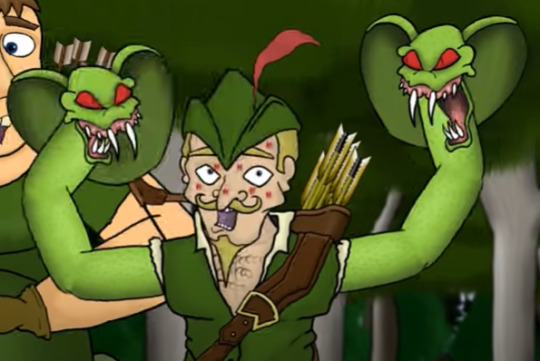
Episode 48
Not content with just having snake arms, how about a snake body:
Damballah’s Child

Shapeshifts the caster into a King Cobra. Can still cast spells. Useful for shadowruns where being a four-meter-long snake isn’t conspicuous.
Herpetology corner! The King Cobra, while venomous, is native to southern and southeast Asia, which is…
Geography corner! …nowhere near New Orleans.

Little Death
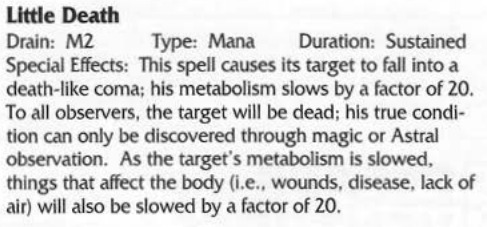
A version of Hibernate that can be used on unwilling targets. If you thought that, given the French influence in New Orleans, that this might refer to la petite mort, the post-orgasmic sensation likened to death, then you are like me.
Spider’s Nest

Remember the spell Full Stomach where the targets stomach fills with spiders and all they can do is vomit them up? This spell creates a pimple that bursts and expels 6D6 spiders. Honestly surprised we didn’t see more spells in this vein.
Spider Sweat.
Spider Urine.
Spidarrhea.
(I’m so, so sorry for that phrase)
Tears of Blood

Subject gets +4 TN due to looking like a magic card.
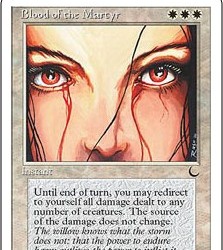
Tentacles
Guess what this does. Go ahead. I’ll wait.

Is it this?

Or this?
It’s this!

They can stretch to [Body] ft in length, and can combine their individual strength (of 1) with others. Time to become polydactyl!
Venom Spew

Allows the caster to spit acidic venom, sort of like a spitting cobra. Lots of snake themes here.
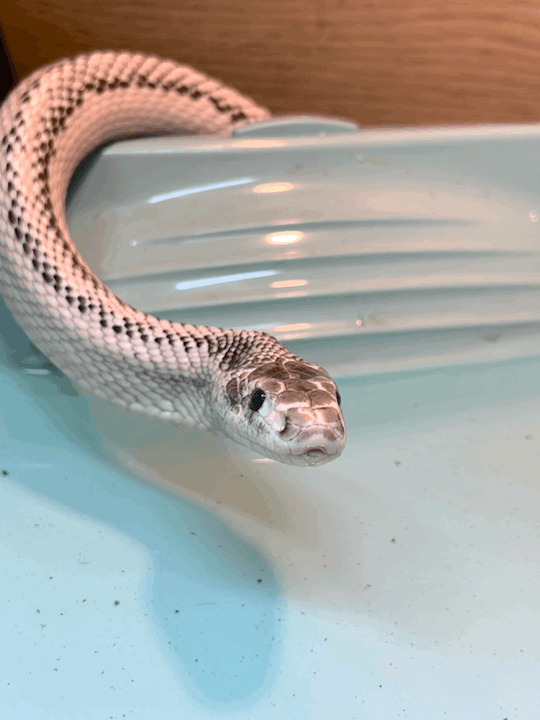
Herpetology corner! Shouldn’t that be a poison, not a venom? Venoms must be injected, whereas a substance interacting across a surface would be classified as a poison.
Herpetology corner corner! No! The toxin delivered by spitting cobras can be done via injection – as a venom – but also by an active and direct physical delivery, known as a toxungen. Poisons involve a passive transfer (ingestion, inhalation, absorption) of the toxin. But note that the venom of spitting cobras isn’t acidic, just toxic.
Herpetology corner! So, there aren’t animals that spit acid?
Entomology corner! There sure are! Fire ants (formic acid)! Whip scorpions (acetic acid)!
*casts little death to end this post*
12 notes
·
View notes
Text

⟨ DANIELLE ROSE RUSSELL. CIS FEMALE. SHE/HER. ⟩ though the mist might prevent some from seeing it, ADELAIDE CROFT is actually a descendent of H Y P N O S. it’s still a question of whether or not the TWENTY-TWO year old CREATIVE WRITING MAJOR from SALEM, USA has taken after their godly parent completely, but the demigod is still known to be quite VENTURESOME & VAIN.
*jennifer coolidge vc* hi a google doc + pinned post are tbd but until then here’s perhaps an equally extensive intro, she’s a menace ty
name: adelaide jane croft nickname: ads, addie (if she likes you), aj (if you want to die) age: 22 dob: august 1, 1998 zodiac: leo sun, ?????? everything else mbti: entj, the commander powers: hypnokinesis, shapeshifting, seeing gods in dream, memory retrieval (minor) positive traits: venturesome, creative, hardworking, independent, ambitious negative traits: vain, cunning, bossy, stubborn, overcritical works: front desk associate at the library clubs and sports: member of book club, chess club, herpetology club, women in leadership club, creative writing club, captain of the debate team, president of feminist alliance, and captain of the cheerleading squad character inspo: blair waldorf (gossip girl), jackie burkhart (that 70′s show), catherine the great (the great), cheryl blossom (riverdale), audrey horne (twin peaks), amy march (little women), cordelia chase (buffy the vampire slayer), fran fine (the nanny), daphne blake (scooby doo)
MENTIONS: alcoholism, coma, neglect
born in salem, massachusetts, adelaide croft is the daughter of sherry croft and hypnos, a product of an affair her mother has on her husband, senator richard croft-- sherry is a bored housewife trapped in a seemingly picturesque but loveless marriage when she meets hypnos, one thing leads to another, nine months later, adelaide is born
richard knows from the get-go adelaide is not his child, it doesn’t take a mathematician to figure out and despite the obvious strain this infidelity puts on the croft marriage, they remain together, richard claiming to the public that adelaide is his daughter while the disdain for what her mother did bubbled into resentment towards the young girl-- growing up she believed he was her real father
the crofts have one other child, an eldest daughter, prudence, and she is the pride and joy of the croft family, things came effortlessly to prudence, who received praise and attention from her parents for the slightest thing-- from a young age, she was actively pit against her older sister, who was as cruel as their father was at times, their relationship founded from rivalry
adelaide struggled for approval from her parents, who often brushed her off or ignored her. while her father was too focused on work, her mother too focused on drinking, and both too focused on prudence, it didn’t help that she developed strange habits from a young age, like claiming to speak to strange people in her dreams or how the world grew drowsy around her
found out she was a demigod at eleven, hypnos came to her in a dream, she laughed in his face, but very quickly realized this was real shit, when he offered the chance to go to a camp where there were other people like that she jumped at the chance-- attended camp halfblood during the summers of 2009-2016
trained pretty extensively during that time, was a casual quester, chosen usually because of her enthusiasm and hypnokinesis abilities, they did not all end well, she lost some people along the way, got some stuck in some sticky situations, will eventually go into more depth with these
when she wasn’t at camp, she was climbing the social ranks back in massachusetts, winning academic awards, prom queen, staying on top of sports, practically anything in an attempt to make her parents acknowledge her, then when she realized they never would, specifically to spite them, simply trying to survive the rest of her high school career
started writing at a young age, journaling originally, but eventually, it grew into short stories, then novellas, etc.
always knew she was going to eonia, however, the process was sped up a little after an incident involving hypnokinesis, prudence, and a five day coma, adelaide denounced the crofts essentially, and using her memory retrieval power successfully for the first and only time, wiped herself from their memories (how long that will last, she is unsure), she went to live with a friend for a bit until she was accepted into eonia
studies creative writing with the intent to write horror fiction based off the nightmares and dreams she has witnessed and influenced, currently in her fourth year here with intent to go to grad school afterwards
TL;DR: the younger daughter of sherry croft and hypnos, adopted by senator richard croft, grew up in a loveless, neglectful household that was seemingly perfect in public eye, had a sadistic older sister name prudence who was always in the spotlight, big queen bee vibes but went to chb and quested a bit, eventually came to eonia to study creative writing.
some headcanons
actually an insomniac, that kind of fuck things up for her, but she finds ways to fall asleep eventually
coffee fiend
chaotic bisexual
weapon of choice is a longsword she got from a quest, affectionately nicknamed tallulah, however she’s proficient in throwing knives and crossbows
has an albino ball python named boris after boris karloff
LOVES halloween and all things horror, surprisingly morbid when you actually get to know her
favorite author is shirley jackson!
will astral project to you to bug you if she’s bored
the gods she has seen the most in her dreams beyond hypnos is hecate, apollo, and athena!!! she details all of the meetings just in case there’s important info
very nosy, will snoop for anything and everything
stressed 25/8
i will update my wc doc asap i don’t have the capacity to do that currently but some wcs include rivals, exes, chb people, friends, enemies, hookups, someone to get her to relax, quest partners, uhhhhh someone she tutors perhaps, muses, hypnokinesis victims, someone she bit while she was a cat!, uhhhh
14 notes
·
View notes
Text
Rainy Days
“Now a soft kiss - Aye, by that kiss, I vow an endless bliss.” -John Keats
Raven was not an outdoorsy person.
Sure, nature was pretty. Of course she thought so; she was wont to meditate on the roof during sunsets and bask in the salty ocean breeze. It was calming and gave her the chance to tune everything else out. She also would not deny the importance of wildlife for society as a whole; economically and otherwise.
But that did not mean she wanted to go traipsing out into the wilderness armed with only a potato rake and bulky, hard-to-walk-in waders.
Raven heaved a very obvious sigh and poked at rotting leaf litter with the butt of her rake. “Do we really need to do this?” she asked for the upteenth time, earning raised eyebrows from her fellow green skinned companion.
“Would you rather pay the city damages?”
She just scowled. This whole excursion was a result of the Titans’ contract with Jump City; they’d pay off any city damages via community service. There was a lost list of services they were provided year-to-year to choose from, ranging anywhere from cleaning trash out of the gutters to helping out at local schools.
This year, the city had given an option to help out at the local university. Apparently the school was short on teaching assistants, and somehow the Titans were qualified to help. Raven figured it had more to do with publicity than anything; after all, they didn’t do much of the actual teaching, they just showed up to classes and held office hours to help the students. Plus, their presence definitely helped the attendance and registration numbers.
Raven hissed, tugging herself free of a thorn bush. The forest was riddled with them, and she was pretty sure her shirt was riddled with holes now.
Biology was fun, Raven wouldn’t deny that. There was something fascinating about how all of biotic aspects of nature just fit together, and she enjoyed reading through various studies and articles. But she didn’t particularly care for field work.
This particular ‘job’ was one-hundred percent Beast Boy’s idea. As soon as he’d seen the class listed on their community service sheet, he’d begged Robin to let him do it. The Titan leader had consented, somewhat baffled by the changeling’s enthusiasm. After all, Beast Boy was not known for his teaching prowess, and he’d requested that Raven accompany him, lest things go south.
But Raven had an inkling that Beast Boy was more interested in the class itself than teaching. Which was why they were now participating in the class field trip out into the depths of a swampy forest, overturning logs and looking for herps.
“Besides,” the shapeshifter said as he expertly rolled over a log, “this is fun!”
Raven raised a brow, unimpressed. “And what exactly is fun about thorns and mud?” All she got for an answer was an excited yelp as Beast Boy dove for the ground. He popped up, holding a wriggling salamander in his hands.
“Dude, check it out! An Ambystoma opacum!”
She blinked. “Wait, you know the Latin names?”
“Uh, yeah.” Bafflement tickled her senses, matching the shapeshifter’s expression as he raised a brow at her. Raven shook herself and padded closer, peering down at the curious looking amphibian. She could admit that it was cute, with its black beady eyes and tiny little feet. The colors were intriguing as well; a black body with white patterns crisscrossing its back, giving the salamander a marbled appearance.
“Yep, it’s a salamander,” she said dryly. “Yet another animal you can shapeshift into.”
Beast Boy rolled his eyes and pulled out a plastic bag, dropping the salamander inside. “Yeah, great, a green marbled salamander. How accurate.” He bent down and scooped up some damp leaf litter and placed alongside the salamander inside the baggie. “We’ve already talked about this; it’s better for the students to get the field experience.”
Raven sighed. He was right of course; they had spoken about it. Repeatedly. Raven had tried to convince Dr. Carrleton, the professor, to merely show the class live specimens via Beast Boy, hoping to escape the obligatory field work. Both protested heavily against it; though Dr. Carrleton did ask the shapeshifter to supplement for any native species they couldn’t find themselves.
There were many reasons, of course, that Raven’s idea was rebuttable; students looking to study herpetology needed to know how to find said herps, how to handle real wild ones, and how to properly and ethically mark, weigh, and potentially collect said creatures. Plus, there was the added obstacle that Beast Boy couldn’t project any color aside from green, though his range was pretty extensive in terms of the color’s spectrum.
“Come on, let’s go check out that creek,” Beast Boy said, cutting through her thoughts. Raven just shrugged and followed after him, carefully picking her way through the shrubs and briar bushes.
The ambling creek carved a path along the forest floor, sloping down into a little gurgling gully. Muddy banks jutted out around the curves and fallen branches and mossy rocks peaked out of the water. Raven watched as Beast Boy leapt into the creek, water spraying out in all directions. She eyes the slopes, trying to figure out the easiest way to join him.
Should she shuffle down? Or find a less steep section?
Light drops splattered on her nose, and Raven directed her gaze upwards. The forest canopy was not quite complete yet, but there were enough leaves developed to obscure her image of the sky. Still, Raven could see hints of grey overhead, and she scowled.
Great. Just what she needed.
“Beast Boy!”
The squeaky voice grated on Raven’s ears, and she cringed. Crashing through the forest were two of the Herpetology students, both of which were currently lusting over Beast Boy like dogs in heat. It was utterly disgusting, the intensity of their desire, and it made Raven want to barf.
“Look what we got!” the first girl squealed, sliding down into the creek with ease. She tossed her golden pony tail as she thrust the baggie into his face, a charming and grotesquely flirtatious grin curved onto her lips. Beast Boy plucked the bag from her grasp, his gaze focused solely on the critter enclosed inside.
“Damn, Lisa, that’s awesome!” He shot the student a playful look. “What species is it?”
Lisa opened her mouth to speak, but her friend on the bank beat her to the punch. “It’s Desmognathus ruber!”
“Yep, that’s right, Emily!” Beast Boy chirped, handing the bad back to Lisa. Emily’s face contorted into a grin so smug, that Raven felt an urge to smack it right off. She suppressed a growl.
Stupid college girls being stupidly inappropriate.
She marched forward, ignoring the rain that was starting to come down harder. Raven jabbed her potato rake into the mud to assist in her descent as she tried to not fall on her face. Unfortunately, Raven misjudged just how muddy the slope was. Her supposedly extra-grip waders did nothing to help her keep her footing, and she found herself sliding down the bank and splashing right into the creek.
Raven floundered, trying to pull herself up out of the water. She coughed and spat out creekwater, barely managing to stagger to her feet.
The section she’d fallen into was deep. So deep, in fact, that her waders were now full of water. Raven bit her lip hard.
Don’t shriek, don’t cry. Don’t shriek, don’t cry.
“Shit, Rae! You okay?”
Beast Boy’s voice broke her out of her reverie, and Raven blinked at the green shapeshifter. He half jogged, half waded through the water, rain dripping off of his face. It was starting to really come down, which was so not helping the situation.
He reached for her wader strap, concern billowing off of him. “Here, let me-”
“Stop!”
A roll of thunder accompanied her voice. She smacked his hand away, narrowing her eyes. “I have had enough of this stupid field trip. I am soaked, muddy, and standing in the stupid rain.” A bitter laugh bubbled from her lips, and she tossed her hands in the air. “And for what? A stupid contract? No. I’m done.”
Raven worked to unfasten her wader straps, her numb fingers fumbling and awkward. Green hands entered her vision and clasped her hands, making her pause.
“Let me help,” Beast Boy murmured. Raven wasn’t sure what it was, but something in his voice enraptured her. The anger she felt dissipated in an instant, and Raven watched dumbly as Beast Boy undid the straps. Some of the water spilled out, though she’d have to actually take the damn things off to get it all out.
“There.”
Raven looked up, catching Beast Boy’s gaze. She sucked in a breath. Wet hair hung in his face, dripping with rainwater. His eyes were bright amid the growing storm, luring Raven deeper into their mossy irises. She felt his thumb brush against her jaw and she shivered.
Tingles spread across her skin, making her feel warm despite the water that clung to her skin and clothes. Raven could feel the college girls watching, but they didn’t seem to matter anymore.
Not with Beast Boy this close.
He kissed her then. His lips tasted of rainwater and peppermint, a taste Raven was quickly becoming addicted to. She hooked her hands into his damp shirt, pulling him closer.
Raven had read many books. She’d encountered countless kissing scenes before, each one more intricate and interesting than the next. But nothing really compared to the feel of Beast Boy’s lips on hers, and the blanket of euphoria that wrapped around them tight.
The broke apart, their foreheads brushing.
“We should probably get out of the rain,” Beast Boy murmured. Raven hummed, glancing up at the obscured sky.
“Perhaps. But I don’t mind staying for a little while.”
The shapeshifter raised his brows, a playful grin warming his features. “Oh?”
She shushed him by kissing him again, there beneath the rain.
I had no clue how to end this. Oh well. Enjoy!
-mod vixensheart
65 notes
·
View notes
Link
Chapters: 8/? Fandom: Yuri!!! on Ice (Anime) Rating: Teen And Up Audiences Warnings: Creator Chose Not To Use Archive Warnings Relationships: Katsuki Yuuri/Victor Nikiforov, Katsuki Yuuri & Yuri Plisetsky Characters: Katsuki Yuuri, Victor Nikiforov, Yuri Plisetsky Additional Tags: Alternate Universe, herpetology, herpetologist Yuuri Katsuki, IguanaYuri, Nagaverse, Naga, SnakeVictor, Yuri is Yuuri's lizard son, Rating May Change, Yuuri is a lizard lover, Protective yurio, alone in the woods, Victor is love, Hiking, Hiking Porn, Mating Rituals, Shapeshifting, Alternate Universe - Shapeshifters Summary:
Ever since he was a boy, Yuuri Katsuki had always wanted to be a herpetologist. When he was eight, he was given a iguana he named Yurio. At twenty-three, he decides to move to a house in the country near the forest. They settle in nicely until one day Yuuri decies to go into the forest to study the snakes until he tumbles down to a small riverbank and loses consciousness. When he come to he realizes two things: He was saved by a beautiful man with blue eyes and a heart shaped smile and...... he was wrapped in a silver tail attached to the man?!
9 notes
·
View notes